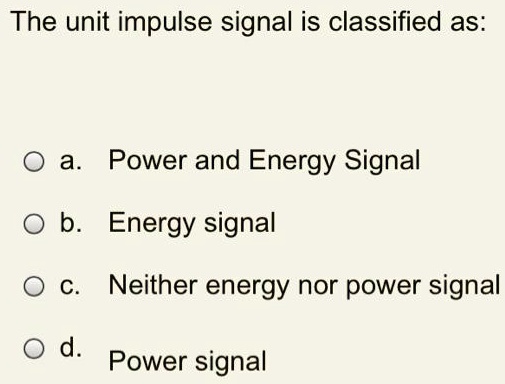The concepts of power and energy are fundamental to understanding various phenomena in physics, engineering, and other fields. Power and energy signals are particularly crucial in the context of signal processing, electrical engineering, and telecommunications. In this article, we will delve into the definitions, differences, and applications of power and energy signals, providing a comprehensive overview of these essential concepts.
Key Points
- Definition and distinction between power and energy signals
- Importance of power and energy signals in signal processing and electrical engineering
- Applications of power and energy signals in telecommunications and other fields
- Methodological approaches to analyzing and processing power and energy signals
- Practical examples and case studies illustrating the use of power and energy signals
Definition and Distinction

A power signal is defined as a signal whose power spectral density (PSD) is finite and non-zero over a specific frequency range. In other words, a power signal has a finite average power, which is typically denoted by the symbol P. On the other hand, an energy signal is defined as a signal whose energy is finite and non-zero over a specific time interval. The energy of a signal is typically denoted by the symbol E. The key distinction between power and energy signals lies in their duration and frequency content. Power signals are typically periodic or stationary, with a finite average power, whereas energy signals are typically aperiodic or transient, with a finite energy.
Mathematical Representation
The mathematical representation of power and energy signals is crucial for understanding their properties and behavior. A power signal can be represented as a function of time, x(t), with a finite average power, P, defined as:
P = (1/T) \* ∫[0, T] |x(t)|^2 dt
where T is the time interval over which the signal is defined. An energy signal, on the other hand, can be represented as a function of time, x(t), with a finite energy, E, defined as:
E = ∫[-∞, ∞] |x(t)|^2 dt
These mathematical representations highlight the fundamental difference between power and energy signals, with power signals having a finite average power and energy signals having a finite energy.
| Signal Type | Definition | Mathematical Representation |
|---|---|---|
| Power Signal | Finite average power | P = (1/T) \* ∫[0, T] |x(t)|^2 dt |
| Energy Signal | Finite energy | E = ∫[-∞, ∞] |x(t)|^2 dt |

Applications and Importance

Power and energy signals have numerous applications in various fields, including signal processing, electrical engineering, telecommunications, and more. In signal processing, power and energy signals are used to analyze and filter signals, removing noise and extracting relevant information. In electrical engineering, power signals are used to design and optimize power systems, including generators, motors, and transmission lines. In telecommunications, energy signals are used to modulate and demodulate signals, enabling efficient transmission and reception of information.
Methodological Approaches
Various methodological approaches are used to analyze and process power and energy signals, including time-domain analysis, frequency-domain analysis, and time-frequency analysis. Time-domain analysis involves examining the signal’s behavior over time, using techniques such as convolution and filtering. Frequency-domain analysis involves examining the signal’s frequency content, using techniques such as Fourier analysis and spectral estimation. Time-frequency analysis involves examining the signal’s behavior in both time and frequency domains, using techniques such as wavelet analysis and short-time Fourier transform.
These methodological approaches enable researchers and engineers to extract valuable information from power and energy signals, including their spectral properties, temporal behavior, and spatial characteristics.
What is the difference between a power signal and an energy signal?
+A power signal has a finite average power, whereas an energy signal has a finite energy. Power signals are typically periodic or stationary, while energy signals are typically aperiodic or transient.
What are some common applications of power and energy signals?
+Power and energy signals have numerous applications in signal processing, electrical engineering, telecommunications, and more. They are used to analyze and filter signals, design and optimize power systems, and modulate and demodulate signals for efficient transmission and reception.
How are power and energy signals analyzed and processed?
+Power and energy signals are analyzed and processed using various methodological approaches, including time-domain analysis, frequency-domain analysis, and time-frequency analysis. These approaches enable researchers and engineers to extract valuable information from the signals, including their spectral properties, temporal behavior, and spatial characteristics.
In conclusion, power and energy signals are fundamental concepts in signal processing, electrical engineering, and telecommunications. Understanding the definitions, differences, and applications of these signals is essential for designing and analyzing systems that process and transmit signals. By applying various methodological approaches, researchers and engineers can extract valuable information from power and energy signals, enabling the development of efficient and effective systems.



